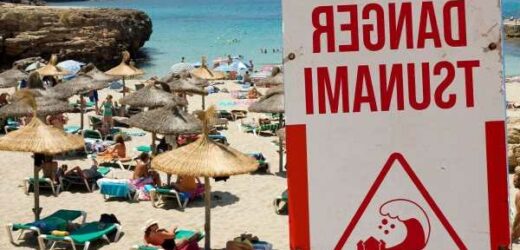Tsunami: National Geographic explain process
We use your sign-up to provide content in ways you’ve consented to and to improve our understanding of you. This may include adverts from us and 3rd parties based on our understanding. You can unsubscribe at any time. More info
The risk of a tsunami in the Mediterranean Sea, whose waters are almost completely enclosed by land, calls for preparation, UNESCO’s Intergovernmental Oceanographic Commission (IOC) warned.
IOC Executive Secretary Vladimir Ryabinin said the effects of such an event, mostly caused by an underwater earthquake, landslide or volcanic eruption, could be “catastrophic”.
He told reporters at a press conference of the Tsunami Ready initiative: “There is no 100 percent chance of it happening, but the chances are very high and we have to be prepared for it.”
READ MORE: Afghanistan earthquake MAPPED – Exactly where it hit
The risk of tsunamis, Ms Ryabinin added, is underestimated by authorities in the Mediterranean area, and that is what Tsunami Ready, an EU-backed project, aims to tackle.
Launched on the Greek island of Kos in 2020, following a small tsunami in 2017, it is committed to making coastal communities the world-over tsunami-resilient.
Some 40 coastal areas across 21 countries are currently recognised by UNESCO as tsunami-ready – a status that will be at the forefront of talks at the UN Ocean Summit in Lisbon on June 27.
Experts brought together by the United Nations Office for Disaster Risk Reduction (UNDRR) and UNESCO-IOC are set to discuss ocean science and innovation at the Coastal alert – Tackling tsunami risks together conference next week.
UNESCO-IOC tsunami programme specialist Bernardo Aliaga said: “The goal is to get 100 percent of coastal areas prepared for a tsunami.”
DON’T MISS
Earth’s core rotation CHANGES and shifts length of a day [STUDY]
Miami airport fire – 3 people hospitalised after blaze on Red Air plane [REPORT]
Russia’s ‘five hands’ that could spark nuclear armageddon [INSIGHT]
Get the latest three-day weather forecast where you live. Find out by adding your postcode or visit InYourArea
He added: “Many of them are vulnerable areas and need to be prepared when faced with this threat.”
Effective coordination between research communities and security and emergency services is crucial in order to respond adequately, Mr Aliaga stressed.
The terrain and vegetation in the area are key elements in the design process of the programmes to help cope with the potential arrival of a tsunami, which, though a rare event, could be deadly.
In the past 100 years, 58 tsunamis have claimed more than 260,000 lives, or an average of 4,600 per disaster, surpassing any other natural hazard.
Additional reporting by Maria Ortega
Source: Read Full Article




